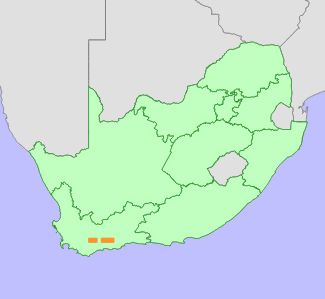|
Scientific Name | Leucospermum erubescens Rourke |
Higher Classification | Dicotyledons |
Family | PROTEACEAE |
Common Names | Oudtshoorn Pincushion (e) |
National Status |
Status and Criteria | Rare |
Assessment Date | 2019/08/12 |
Assessor(s) | A.G. Rebelo, H. Mtshali & L. von Staden |
Justification | Leucospermum erubescens is a rare and localized species, with an Extent of Occurrence of 764 km², and an Area of Occupancy of 156 km². There has been a very small population reduction due to habitat loss in the past, but there is no significant ongoing habitat loss. It is therefore not in danger of extinction. |
Distribution |
Endemism | South African endemic |
Provincial distribution | Western Cape |
Range | Leucospermum erubescens is endemic to the Langeberg Mountains in the Western Cape, South Africa, where it occurs between Montagu and Riversdale. |
Habitat and Ecology |
Major system | Terrestrial |
Major habitats | North Langeberg Sandstone Fynbos |
Description | It occurs on dry, rocky, lower north-facing slopes and gravelly flats in sandstone fynbos, 350-1000 m. Mature individuals are killed by fires, and only seeds survive. Seeds are released after ripening, and dispersed by ants to their underground nests, where they are protected from predation and fire. It is pollinated by birds. |
Threats |
| There has been population decline at two subpopulations in the past. Part of the large subpopulation on the northern side of Garcia's Pass was lost to crop cultivation, where plants occur on richer soils on lower slopes. Remaining subpopulations however occur in areas unsuited to cultivation, and this is unlikely to cause an ongoing decline. Overall, only 7% of this species' habitat is irreversibly modified, and there has been no significant loss since 1990. Some subpopulations are potentially threatened by road construction and competition from alien invasive plants. This species is wild-harvested for the cut flower industry, but not in large enough volumes to be concerning. |
Population |
This species occurs in small, scattered subpopulations along the northern foothills of the Langeberg. The largest subpopulation is on the northern slopes of the Leeurivierberg, where there is between 327 and 28 350 plants. There has been some isolated declines due to habitat loss in the past, but significant ongoing decline is unlikely.
|
Population trend | Stable |
Assessment History |
Taxon assessed |
Status and Criteria |
Citation/Red List version | | Leucospermum erubescens Rourke | Rare | Raimondo et al. (2009) | |
Bibliography |
Goldblatt, P. and Manning, J.C. 2000. Cape Plants: A conspectus of the Cape Flora of South Africa. Strelitzia 9. National Botanical Institute, Cape Town.
Raimondo, D., von Staden, L., Foden, W., Victor, J.E., Helme, N.A., Turner, R.C., Kamundi, D.A. and Manyama, P.A. 2009. Red List of South African Plants. Strelitzia 25. South African National Biodiversity Institute, Pretoria.
Vlok, J. and Schutte-Vlok, A.L. 2010. Plants of the Klein Karoo. Umdaus Press, Hatfield.
|
Citation |
| Rebelo, A.G., Mtshali, H. & von Staden, L. 2019. Leucospermum erubescens Rourke. National Assessment: Red List of South African Plants version . Accessed on 2025/07/03 |
 Comment on this assessment
Comment on this assessment

